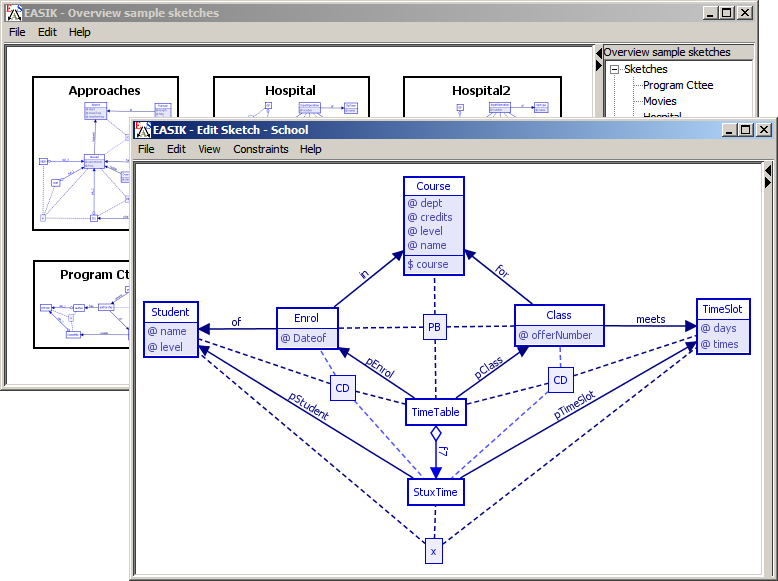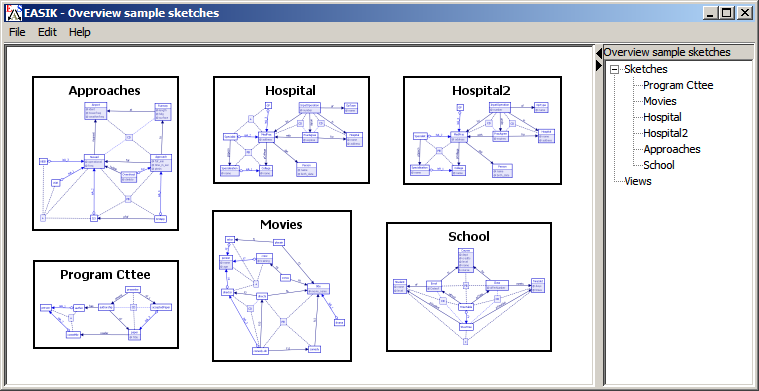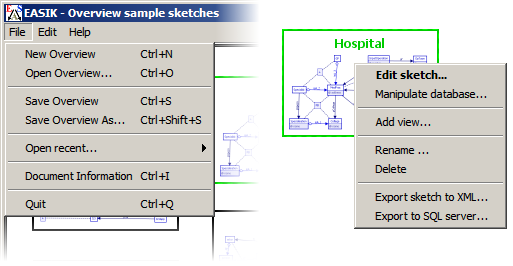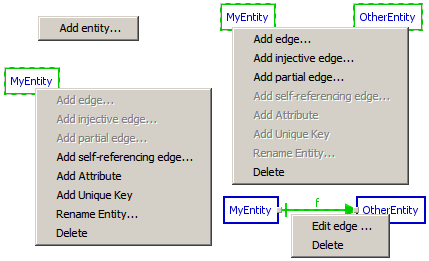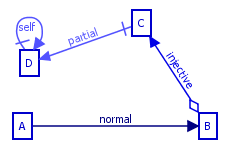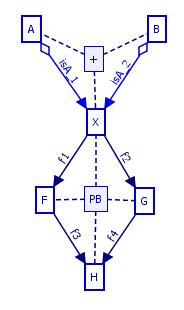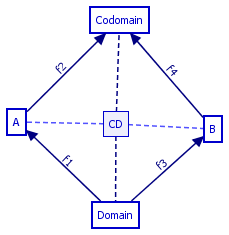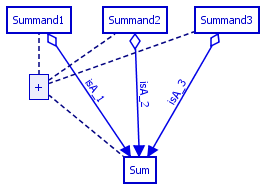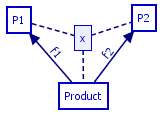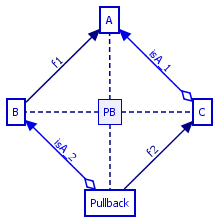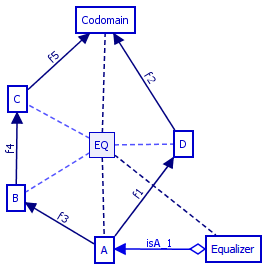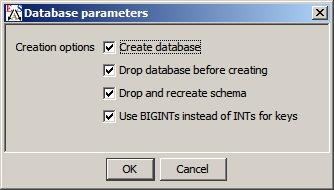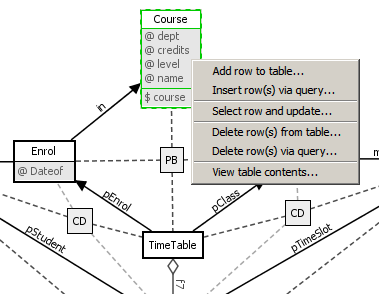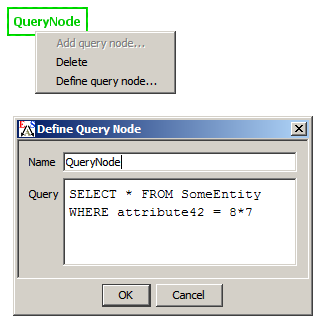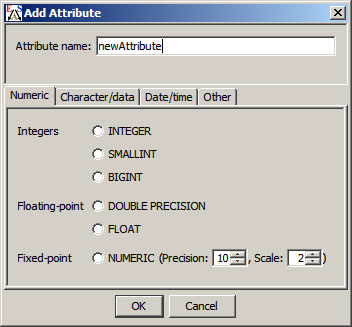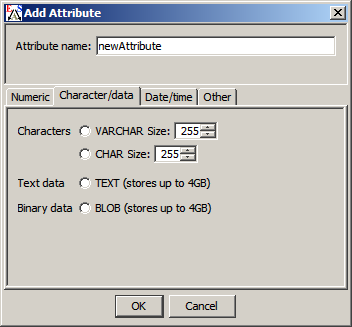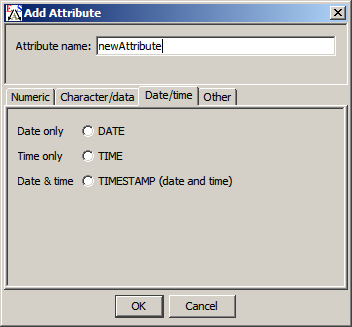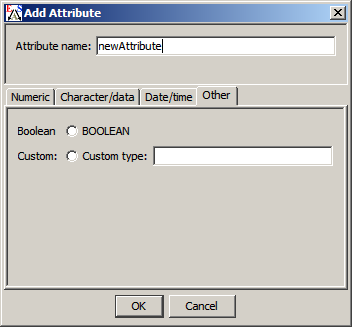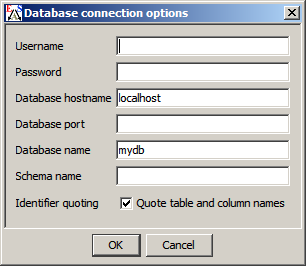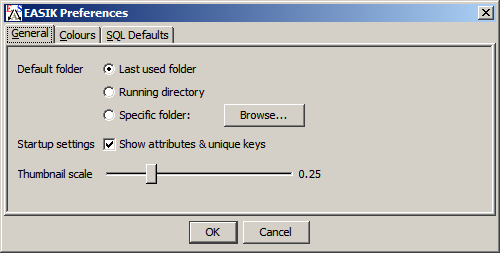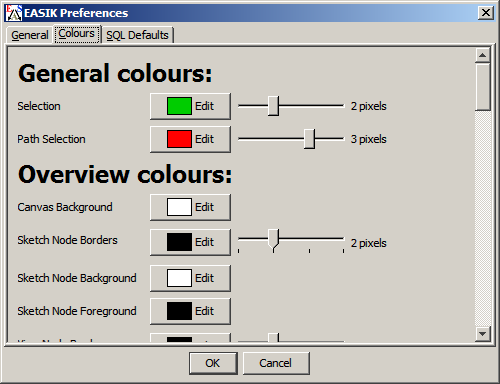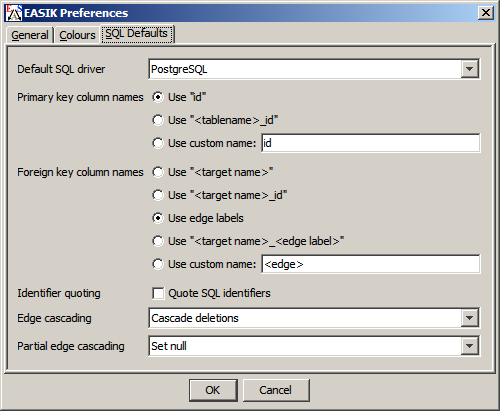Introduction to Easik
Introduction to Easik
Easik is a Java based development kit for EA sketches. Easik allows
graphical modelling of EA sketches and views. This information can
be converted to SQL code and then saved as a text file, or exported
directly to a database. Once exported, Easik supports interaction
with the new database which allows the user to experiment with
design decisions.
Any suggestions to make Easik a better product should be directed to
rrosebrugh@mta.ca
Overview
Introduction
The overview window opens when
Easik is started and remains open throughout the program's entire
execution. The overview window allows the user to have
multiple sketches open for editing simultaneously and allows the
definition views of sketches.
Editing Overview
The editing actions available when working with the overview:
-
New Overview (File | New Overview):
Creates a fresh canvas containing no sketches or views. Any
unsaved work will be lost.
-
Save Overview (File | Save Overview):
Saves the current overview to an XML file. Note: overview
files are saved with a .easik extension.
-
Open Overview (File | Open Overview):
Opens an overview from a .easik file. Any unsaved work will
be lost.
-
Edit sketch (Right click on desired sketch → Edit sketch): See opening
a sketch to edit.
-
Manipulate database (Right click on desired sketch → Manipulate database): See opening a sketch to manipulate a database.
-
Export Sketch to XML (Right click on sketch → Export sketch to XML): See exporting a sketch to XML.
-
Export Sketch to SQL Server: See exporting a sketch to SQL server.
-
Add Sketch (Right click → Add sketch OR Edit | Add sketch): Adds a new empty sketch to the
overview canvas.
-
Import Sketch (Right click → Import sketch OR Edit | Import sketch):
To import a sketch (and its views) from an XML file, right click on
the overview and select Import sketch from the popup menu.
(The action is also available through the Edit menu.) Select the
XML file and click OK to add it to the overview.
-
Add View (Right click on sketch → Add view): Creates a new empty view of the
selected sketch.
-
Rename (Right click on sketch or view → Rename): Prompts the user for the new name of the
selection.
-
Delete (Right click with sketches and/or views selected → Delete): Deletes the current
selection.
Opening a Sketch in Edit Mode
To open a sketch for editing, it must exist as a sketch node in the
overview. Right clicking on the sketch node and selecting Edit
sketch from the popup menu will open the sketch for editing.
If there is currently no active connection to an SQL server, a double
click will also enter edit-mode. If there is an active connection to
a database, a double-click will open the sketch in data manipulation mode.
Note: A sketch cannot be edited if it has been exported to an SQL
server. If the user wishes to make edits to the sketch, they must
first verify that they realize that edits will break the
sketch/database synchronization.
Opening a Sketch in Data Manipulation Mode
To open a sketch in data manipulation mode, right-click over the
sketch's representation in the overview and select Manipulate
database from the popup menu. If a valid SQL connection currently
exists, Easik will immediately enter data manipulation mode on the
selected sketch. If there is no such connection, the user is
prompted for connection information,
and a connection attempt is made. Should a connection establish
successfully, data manipulation mode will be entered. See database manipulation.
Opening a View
From the overview, a view can be opened to edit by either right
clicking over it and selecting Open view from the popup menu,
or double clicking over it.
Editing a Sketch
Sketch Editing Actions
This section outlines the actions available when editing a sketch.
(See opening a sketch to
edit.) Note that any action specified to be in a popup menu
can also be found in the Easik Edit menu. If the action requires
information about position on the sketch (such as adding an entity),
a random position is used.
Edit Sketch - Popup Menus
Add Entity
Right-click at the position on the
canvas where the new entity should be placed. Select
Add entity... from the popup menu.
Add Edge
Easik supports four types of edges: edge, injective edge, partial edge, and self-referencing edge.
To add an edge to the sketch, highlight the desired entities and
select Add <edge-type> from the popup menu.
Note that self-referencing edges require only one node,
while the others require two. A dialog appears prompting for
the edge's name and cascade
behaviour.
Add Attribute
Right click on an entity and select Add Attribute from
the popup menu. A dialog pops up prompting for the new
attribute's name and type.
Edit Attribute
Right click on the attribute in the information tree located at
the right of the sketch window and select Edit Attribute
from the popup menu. The selected attribute can then be renamed,
and its type redefined.
Delete Attribute
Right click on the attribute in the information tree located at
the right of the sketch window and select Delete
Attribute from the popup menu. The selected attribute
will then be deleted from its entity.
Add Unique Key
Right click on an entity that has at least one attribute or at
least one non-injective edge and select Add Unique Key
from the popup menu. A dialog pops up prompting for the key's
name, attributes and edges. Control-click to select multiple
attributes/edges.
Edit Edge
Right click on an edge and select Edit edge from the
popup menu. A dialog pops up allowing the edge to be renamed
and its cascade behaviour specified.
-
Restrict:
Causes attempted deletions of referenced rows to fail.
-
Cascade:
Cause deletions in this table to trigger deletions of
any rows in other tables that point to the row(s) being
deleted.
-
Set null:
Causes references to be set to NULL when the targeted
row is deleted (only available on partial edges.)
Rename Entity
Right click on an entity and select Rename Entity from
the popup menu. A dialog pop up prompting for the entity's new
name.
Delete
Right click with any combination of entities and edges
highlighted. Choosing Delete from the popup menu will
remove the highlighted selection from the sketch.
Edge Types
This section describes the four types of edges available within Easik.
See Add Edge for details on adding an edge.
Normal edges
The normal edge type in Easik is a non-nullable reference to a row
of another entity. This represents a many-to-one relationship between
entities.
Injective edges
Injective edges are non-nullable, unique references to a row of another
entity. Because the reference must be unique, this represents a
one-to-one relationship between entities, and is often used to "is-a"
relationships between entities.
Partial edges
Partial edges are like normal edges, but may be null; that is, they may
not reference a tuple of another entity at all.
Self-referencing partial edges
Self-referencing edges allow tuples of an entity to refer to other
tuples of the same entity. These edges must be partial: it would not
be possible to insert the first tuple of a table if a null value for
the reference value was not permitted. Self-referencing edges can be
useful for representing tree or graph structures within a database.
Constraints
There are several EA constraints which can be implemented and
represented graphically using Easik. These constraints include
commutative diagrams,
sum constraints,
product
constraints,
pullback constraints and
equalizer constraints. Defining constraints
requires selecting paths in the sketch. This is done by successive
ctrl-clicks on composable edges and then clicking
Next or
Finish as described below. Note that by definition, some
entities involved in constraints have rows that are automatically
generated. Easik restricts insertion and deletion on such
entities.
Warning!
Invalid Interacting
Constraints
We cannot guarantee the correctness of interacting constraints. Our
implementations make some combinations invalid. Such an example is
when a pullback is a sum. The pullback constraint will try to
insert into a table that has, due do a sum constraint, had
insertions restricted.
Commutative Diagram
To add a commutative diagram constraint, select Add a Commutative
Diagram from the Constraints menu.
Select the first path involved in the commutative diagram. This path
should begin with the domain of the commutative diagram and should
terminate at the co-domain. Once the path is selected, click
Next.
After selecting the first path, the user will then be prompted to
select the second path. Once the second path is selected, the user
may then choose Next or Finish depending on whether
more paths are involved in the commutative diagram constraint, or
whether all paths are accounted for. The user will continue to be
prompted to add more paths to the commutative diagram until the
Finish or Cancel button is pressed. There is no upper
bound to how many paths can be involved in a commutative diagram.
Should the commutative diagram requirements be violated, an
error will be produced and no path will be built.
After it is created, new paths can be added to the constraint by
right clicking over it in the sketch and selecting Add path(s) to
constraint. Path selection works as described above.
Sum Constraint
To add a sum constraint to the sketch, select Add Sum
Constraint from the Constraints menu. Select the first path
involved in the constraint. This path should begin at a summand and
end at the sum. Confirm this path by pressing the Next button
at the bottom of the window.
After selecting the first path, the user will then be prompted to
select the second path. Once the second path is selected, the user
may then choose Next or Finish depending on whether
more paths are involved in the sum constraint, or whether all paths
are accounted for. The user will continue to be prompted to add more
paths to the sum constraint until the Finish or Cancel
button is pressed. There is no upper bound to how many paths can be
involved in a sum constraint.
There are several conditions which must be observed for the
successful creation of a sum constraint:
-
All paths involved must target the same entity
-
All paths involved must have the first edge in the path be an injective edge
-
At least two paths must be selected
Should these conditions not be met, an error message will appear, and the
constraint will not be created.
After it is created, new paths can be added to the constraint by
right clicking over it in the sketch and selecting Add path(s) to
constraint. Path selection works as described above.
Product Constraint
To add a product constraint to the sketch, select Add Product
Constraint from the Constraints menu. The user will
then be prompted to select the first path involved in the
constraint, and confirm this path by pressing the Next button
at the bottom of the sketch pane.
After selecting the first path, the user will then be prompted to
select the second path. Once the second path is selected, the user
may then choose Next or Finish depending on whether
more paths are involved in the product constraint, or whether all
paths are accounted for. The user will continue to be prompted to
add more paths to the product constraint until the Finish or
Cancel button is pressed. There is no upper bound to how many
paths can be involved in a product constraint.
There are several conditions which must be observed for the
successful addition of a product constraint:
Should these conditions not be met, an error message will appear.
After it is created, new paths can be added to the constraint by
right clicking over it in the sketch and selecting Add path(s) to
constraint. Path selection works as described above.
Pullback Constraint
To add a pullback constraint to the sketch, select Add a Pullback
Constraintfrom the Constraints menu. The user then defines
the paths involved in the pullback constraint. The paths must be selected
in the correct order.
The first and second paths must have a common codomain, the codomain
of the pullback. The third path must have the pullback entity as its
domain and its codomain must be the domain of the
first selected path. The fourth path has the pullback entity
as its domain and its codomain must be the domain of the
second selected path. After the fourth path is selected,
click Finish.
There are several conditions which must be observed for the
successful addition of a pullback constraint:
-
The first and second paths must have a common codomain
-
The third and fourth paths must have a common domain
-
The codomain of the third path must be the domain of the first;
the codomain of the fourth path must be the domain of the second
Should these conditions not be met, an error message will appear, and the
constraint will not be created.
Equalizer Constraint
To add an equalizer constraint to the sketch, select Add Equalizer
Constraint from the Constraints menu. The user will then be
prompted to select the first path involved in the constraint. This
path must be a single injective edge that has the equalizer entity
as its domain. Confirm this selection by pressing the Next
button at the bottom of the window.
After selecting the first path, the user will then be prompted to
select the second path. Its domain must be the codomain of the first
path. A third path with the same domain and codomain as the second
path must be selected, and the user may then choose Next or
Finish depending on whether more paths are involved in the
equalizer constraint, or whether all paths are accounted for. The
user will continue to be prompted to add more paths to the equalizer
constraint until the Finish or Cancel button is
pressed. There is no upper bound to how many paths can be involved
in a equalizer constraint.
There are several conditions which must be observed for the
successful addition of an equalizer constraint:
-
The first path must be an injective edge
-
All paths (excluding the first) have as their source the
target entity of the first edge
-
All paths (excluding the first) must have the same entity
as their target
Should these conditions not be met, an error message will appear, and the
constraint will not be created.
Adding Paths
Some constraints support path addition after their creation. These
include commutative
diagrams, product constraints, and
sum constraints. To add one or more paths to a constraint,
right click on its node and select Add path(s) to constraint
from the popup menu. Paths can then be selected by successive
ctrl-clicks on composable edges and clicking either next to
select another path, or finish to add the selected paths to
the constraint.
Sketch Exporting
This page describes the various ways of exporting an Easik sketch.
Exporting a Sketch to an SQL Server
This action is started by right clicking on the desired sketch from
the overview and selecting Export to SQL server from the
popup menu. If there is currently no active connection to a
database, the user is prompted for connection
information and database parameters. The following is
a list of the database parameters.
-
Create database: Set database definition to create a
new database.
-
Drop database before creating: Available if
Create database enabled. Sets database definition to
drop an existing database in the event of a naming conflict.
-
Drop and recreate schema (PostgreSQL only):
Sets database definition to drop and recreate a schema in
the event of a naming conflict.
-
Use BIGINTs instead of INTs for keys:
Enabling this option changes the type of foreign key
columns and the primary key
columns to which they point from the default of
int(11) to bigint(20).
Once a connection is established, the sketch (and its views) are
converted to SQL code (see notes on shadow edges) and
sent to the server. The database is created and the sketch is
opened in data manipulation mode.
The user can now interact with the new database. Note that this
export action can also be found in the file menu of the sketch
window - File | Export to | SQL server.
Exporting a Sketch to XML
To export a sketch to an XML file, right click on its representation
in the overview and select Export
sketch to XML from the popup menu. The action can also be
fired through the menu bar in the sketch window - File | Export to |
XML. Select where the XML is to be saved and click OK. Note that all
views of this sketch are automatically exported. Note also that
these XML files are given a .sketch extension. See import sketch for
details on importing.
Exporting a sketch to an SQL Text File
This action can be fired from the file menu of the sketch window -
File | Export to | SQL text file. The following
steps are then taken to export the sketch to an SQL text file.
-
Select SQL dialect (MySQL or PostgreSQL).
-
Select database
parameters.
-
Enter database connection options
-
Database name: The name used for the new
database.
-
Schema name (PostgreSQL only): The name
used for the new schema.
-
Identifier quoting:
See identifier
quoting for details.
-
Select where the SQL text file is to be saved and click OK.
See shadow edges
for details on auto-generated SQL code.
Export a Sketch to Image File
This action can be fired from the File menu in the sketch window - File |
Export to | Image. Select where to save the image file and click OK.
The default image type is png. The image type is specified by
including its extension in the filename. Supported image types are
png, jpeg, gif, and bmp.
Database Manipulation
Setup
In order to manipulate a database which has been created through
Easik, the following conditions must be met:
By a compatible database, we mean a database onto which our
sketch maps. (Entities to tables, attributes to columns, edges to
foreign keys, constraints to triggers and unique keys to unique
indexes.) There is currently no utility to automatically detect
compatibility between database and sketch. If an export was
triggered from within Easik and no editing has been done to the
sketch since, we trust that the user has not connected to the server
by other means and altered the database. We therefore assume the
database is compatible. If, however, our sketch has no knowledge of
a database synchronization (e.g. it was created by an
Easik-generated SQL text file) the user is prompted to verify
that they are indeed connecting to an appropriate database.
Manipulation Actions
The section outlines the actions available by right clicking on an
entity while the sketch is open in data manipulation mode. Note
that as mentioned in constraints,
insertion and deletion is restricted on some entities.
Sketch Manipulation Mode - Popup
Menus
-
Add Row to table: Adds a row to
the highlighted table. The user specifies values for each
column through a popup dialog. In some cases, extra columns may
be specified (see shadow edges).
-
Insert row(s) via query: Pops up a query dialog from
which the user is free to execute any SQL INSERT query.
-
Select row and update: The user is prompted to select
a row from the highlighted table. A dialog is then displayed
that allows the user to update any of the row's column values.
-
Delete row(s) from table: The user is prompted to
select one or more rows from the highlighted table. The selected
rows are then deleted from the table. Note that cascade
behaviour for affected edges is invoked.
-
Delete row(s) via query: Pops up a query dialog from
which the user is free to execute any SQL DELETE query. cascade
-
View table contents: Displays the contents of the
highlighted table on the screen.
Shadow Edges
As noted on the constraint page, some
constraints automatically generate rows in tables that are involved
in the constraint. For example, insertion into a summand causes
insertion into the sum entity (and possibly into intermediate
tables between the sum and the summand, for summands with paths
consisting of multiple edges). All attributes and partial edges
for these new rows will be set to NULL (they can be updated manually
after the insertion operations are complete), however regular and
injective edges are foreign keys that are not nullable. To work
around this, when Add Row to Table
is selected, the user is given the option to select values for
foreign keys from those tables in which new rows may be generated.
This is implemented by foreign keys from the table at which the
initial insert occurs to the target table for the actual foreign
key, and handled in the triggers generated when exporting a sketch
to SQL. These are called shadow edges. If conditions are
right for a row to be generated, the specified values for shadow
edges will be used for the generated rows.
It is important to note that the provided shadow edge values
are not necessarily used, as some insertions do not necessarily create
new rows in constraint tables. For instance, inserting into a table involved
in an pullback that does not form a matching pair will not result in any
new entry in the pullback table. Thus, shadow edge values are not always
required, though insertion will fail if an edge is required but has not been
specified.
There is no practical limit to the number of shadow edges Easik
supports, though very complex cases--such as using complex path
loops and overlapping paths for different constraints--may result in
a situation where insertion fails or does not provide enough
differentiation possibilities. For example, suppose entity n were
involved in three different constraint paths that need to be created
for an insertion: only a single n value can be specified, though
it is quite possible that each path should refer to a different n
value. The workaround for EASIK currently is that the n values of
each row be updated after the necessary rows have been created.
Note that because of MySQL limitations, shadow edges in MySQL will
retain shadow edge values. These should not interfere with any use
of the tables as they set themselves to null if their target is
deleted or updated, but note that these shadow edge foreign keys are
not meant to be used after insertion. Under PostgreSQL, the shadow
edges will always be set to null once constraint operations
complete.
View
Easik currently supports read-only views. See
adding and
opening views. Views of a sketch
are automatically included when the sketch is exported to XML or SQL.
Editing a View
View - Editing Popup Menus
A view in Easik is simply a collection of query nodes. A query node is
a named node on the view canvas that represents an SQL SELECT query.
-
Adding a Query Node (Right click → Add query node): The user is prompted for the query node name.
This will become its SQL view name when exported to SQL. The
query entered is an SQL SELECT statement that the view implements.
-
Editing a Query Node (Right click → Define query node OR double-click): The user is prompted for a new name
and new SELECT statement for the selected node.
Data Types
Easik supports many SQL data types for attributes, and allows you to
specify any additional data type supported by your database. Note that the
main data types listed here may be slightly different, depending on the SQL
dialect in use (for example, the TEXT type becomes a LONGTEXT when
exporting to MySQL).
Numeric Types
The following numeric types are available:
-
INTEGER:
An integer value field (usually a 32-bit int) that stores
integer values from -2147483648 to 2147483647"
-
SMALLINT:
An integer value field (usually a 16-bit int) that stores
integer values from (at least) -32768 to 32767
-
BIGINT:
An integer value field (usually a 64-bit int) that stores
integer values from -9223372036854775808 to 9223372036854775807
-
DOUBLE PRECISION:
A floating point value with at least 15 digits of precision
(typically a standard 64-bit floating-point value with 53
bits of precision)
-
FLOAT:
A floating point value with at least 6 digits of precision
(typically a standard 32-bit floating-point value with 24 bits
of precision). This is sometimes known as a REAL, but a REAL is
also sometimes an alias for a DOUBLE PRECISION
-
NUMERIC:
A fixed-point numeric type. Also known as DECIMAL. This type
is substantially slower than integer and floating-point types,
but guarantees precision for the range of values it supports.
The precision value is the total number of digits storable, and
the scale is the number of digits stored after the decimal
point. "12345.67" has precision 7 and scale 2.
Character/Data Types
The following character and data types are available:
-
VARCHAR:
Stores a string of characters of up to size characters. Unlike
a CHAR, a VARCHAR column is typically stored using the minimum
storage space required, while a CHAR field pads shorter strings
to always store values of size length.
-
CHAR:
Stores a string of characters of up to size characters. Unlike a
VARCHAR, a CHAR column is typically padded up to the specified
size to make it a fixed-width column (the padding is removed on
retrieval). Note that some databases implicitly convert CHAR
columns to VARCHAR if other variable-size columns exist in the
table.
-
TEXT:
Stores large amounts of text data. Also sometimes known as a CLOB.
-
BLOB:
Stores large amounts of binary data (bytes). Will result in a
BYTEA under PostgreSQL.
Date/Time Types
The following date/time types are available:
-
DATE:
A date field that does not include a time, such as "2008/07/14".
-
TIME:
A field that stores just a time (e.g. "12:13:14").
-
TIMESTAMP:
A field that stores a date and time (e.g. "2008/07/14 12:13:14"). Note that this
is converted to a DATETIME when using MySQL.
Other
The following other types are supported by Easik:
-
BOOLEAN:
A column that stores true/false values. Note that this type may
be converted to a small integer type by databases (such as
MySQL) that do not fully support BOOLEAN data types.
-
Custom Data Type:
This allows you to specify any data type supported by your database.
Note that the type you enter here will not be checked for
correctness: ensure that the provided type is valid for the SQL
type(s) you intend to use.
Database Connection
Easik requires an active connection to an SQL server for some of its
functionality, such as exporting a sketch to database and manipulating a
database which is defined by an Easik sketch. When Easik determines that a
connection is needed, if a one has not previously been established, the
user has the option to make a connection.
Establishing a connection
-
Select an SQL dialect (MySQL or PostgreSQL).
-
Select database parameters.
If exporting, the user is prompted for
database parameters.
-
Enter database connection options:
-
Username: The username on the database server.
-
Password: <Username>'s password on the database server.
-
Database hostname: Location of the database server.
-
Database port:
The port on which to attempt the connection. Defaults are used when
this field is left blank.
-
Database name:
The name of the database that is defined by the current sketch. If
exporting the sketch, this is the name that will be given to the
new database. If connecting to a database, this must be the name
with which the sketch had been exported.
-
Schema name (PostgreSQL only):
The name of the schema in which this sketch exists in the database.
If exporting the sketch, this is the new schema name. If connecting
to a database, this must be the name of the schema in which this
sketch exists.
-
Identifier quoting:
If enabled, this setting will make EASIK use SQL identifier quoting
when interacting with the database. When enabled, this allows you
to use non-alphanumeric values in entity, edge, and attribute
names, which will be preserved in the generated SQL tables. Note,
however, that if quoting is used, it must continually be used,
including other tools accessing the database (for MySQL, this means
using `identifier`, and for PostgreSQL, "identifier"). Also note
that for PostgreSQL, enabling identifier quoting will make table
and column names case-sensitive.
When disabled, non-alphanumeric characters will be converted to
underscores.
This setting defaults to off, and should not be enabled unless
the above is desired.
Also note that when an entity or attribute conflicts with a
built-in SQL keyword for the driver being used, quoting of the
identifier will be forced, even if this setting is disabled.
Preferences
Preferences are accessed through the Edit → Preferences menu of an overview
or a sketch that is open for editing.
(Note: on Mac OS X, the Preferences option is in the standard location
in the main application menu, rather than the Edit menu).
General
General preferences control the main Easik settings.
Path
The path setting defines the default system folder Easik uses when
opening or saving files. You can set this to be the last folder a
file was opened or saved from ("Last used folder"), the folder Easik
was started from ("Running directory"), or a specific folder.
The default setting is the last used folder.
Show attributes & unique keys
This option controls whether or not attributes and unique keys are displayed
in new sketches. The default option is enabled. This can be controlled for
a sketch which is open for editing from the sketch window's Edit menu.
The default setting is the last used folder.
Thumbnail scale
This option controls the size of sketch and view thumbnails displayed in the overview. A
setting of 0.25 means that the thumbnail of sketches and views will be ¼
of their actual size; 0.5 would indicate ½ of the actual size.
The default setting is 0.25 (¼ size).
Colours
Colour settings control the look and feel of Easik sketches, views, and
the main overview window.
The colours tab allows you to adjust the colours and, in some cases,
line widths, used within Easik for displaying sketches, overviews, and
views. To change a colour, click the Edit button beside the colour
you wish to change. To change a line or border width, drag the slider
beside the colour to select the desired width.
SQL Defaults
The SQL Defaults settings allow you to control the default settings to be used
when connecting to a database, to manipulate an
existing set of tables, or export a sketch to a database.
SQL Defaults preferences tab.
Default SQL driver
This setting controls the default SQL driver used when connecting and
exporting. Currently, MySQL and PostgreSQL database connections
are supported.
Primary key column names
This setting controls how the primary key column will be named when
exporting a sketch to an SQL server or an SQL file.
The default, "id", uses the name "id" for the primary key of all tables.
Alternatively, "<tablename>_id" can be used to base the primary key
column on the table name: for example, the primary key of the entity
"Car" would be "Car_id". You can also use a custom name; <table>
in this custom field will be replaced with the table name.
Foreign key column names
This setting controls how foreign keys will be named when exporting a sketch
to an SQL server or SQL file.
The default, "Use edge labels", will use the label specified for an edge name in
a sketch as the foreign key column. Alternatively, you may use the target table name
followed by the edge label, target table name alone, and target table name followed by
_id name "id" as the foreign key columns. Note that using a foreign key that does
not contain the edge label will not work if there are parallel edges between
entities. You may also specify a custom naming scheme: <source>
will be replaced with the source entity name; <target> with the
target entity name; and <edge> with the edge label.
Edge cascading
This setting allows you to set the default cascading mode for foreign keys (edges).
Note that you can also specify this for each edge within a sketch: this setting
controls only the default cascading mode.
The two options here are cascading, and restricted. Cascading deletions means that
when deleting a row, any referenced rows will also be deleted (subject to any foreign
keys of the referencing rows). Restricted disallows any deletion while a row is
still referenced.
The default Easik setting is cascading deletions.
Partial edge cascading
This setting allows you to set the default cascading mode for partial edges (in
SQL, these are nullable foreign keys). In addition to the two options available
for edge cascading, you may also specify "Set null":
this option sets any referring foreign key values to NULL when deleting a row.
The "Set null" option is the default for partial edges.
